Transforming Road Safety through AI-Driven Lane Detection: An In-Depth Guide with Matrice
In the era of autonomous driving and advanced driver assistance systems (ADAS), artificial intelligence (AI) is transforming how we approach road safety and vehicle navigation. One of the most critical components in modern automotive technology is efficient lane detection. Traditional methods rely heavily on basic computer vision techniques, which can struggle in varying lighting conditions, weather, and road qualities. This comprehensive guide illustrates how to leverage computer vision through Matrice’s platform and SDK to develop a highly accurate, AI-driven lane detection system, revolutionizing road safety and autonomous navigation.

Understanding Computer Vision in Traffic and Road Safety
Computer Vision (CV) has revolutionized road safety by enabling real-time lane detection, traffic monitoring, and rapid responses to potential hazards. Here’s how CV enhances traffic and road safety:
Handling Various Image Sources: CV processes data from multiple camera types, including RGB, infrared, and depth cameras, providing a multi-dimensional view for precise lane and obstacle detection.
Enhanced Pattern Recognition: CV can distinguish lane markings, even under challenging conditions like faded lines, poor lighting, or inclement weather.
Continuous Monitoring: Automated systems with CV can operate around the clock, providing 24/7 lane detection and traffic management support.
Real-Time Alerts: With real-time decision-making, CV-powered systems can instantly detect lane departure or potential collisions, providing immediate alerts to enhance driver response and safety.
Why is Road Lane Detection Important?
Imagine driving on a busy road without lane markings – it’s chaotic, right? Lanes provide structure and safety, guiding vehicles to maintain order and stay within bounds. Road lane detection is essential for multiple reasons:
Enhancing Safety: Lane detection enables systems like lane-keeping assist, which helps drivers avoid unintentional lane departures that could lead to collisions.
Improved Lane-Keeping: By accurately identifying lane boundaries, CV aids in lane-keeping assistance, minimizing accidents due to unintended lane departures.
Traffic Flow Optimization: CV helps to manage traffic patterns, enabling adaptive control systems that adjust signals and reduce congestion.
Enhanced Driver Assistance: Automated lane detection supports Advanced Driver Assistance Systems (ADAS), giving drivers alerts or corrective actions for safe driving.
Environmental Adaptability: AI-driven CV systems are robust, adapting to varying road and weather conditions, thus ensuring reliable detection at all times.
These capabilities make road lane detection indispensable for both modern vehicles and future autonomous fleets.
The Challenge with Traditional Lane Detection
Reliable lane detection is crucial for both driver assistance and autonomous driving. Traditional lane detection techniques face several limitations:
Lighting Variations: Changes in lighting conditions can affect the visibility of lane markings.
Weather Impact: Rain, snow, or fog can obscure lane markings and affect detection accuracy.
Road Variations: Different road types, qualities, and marking styles present challenges for consistent detection.
Occlusions: Other vehicles, shadows, or road debris can temporarily block lane markings.
Complex Scenarios: Intersections, merging lanes, and construction zones require sophisticated detection capabilities.
The Solution: Matrice’s No-Code Platform
Matrice addresses these challenges with a cutting-edge lane detection solution through its No-Code Platform Interface. This platform enables users to effortlessly set up and deploy lane detection models via a user-friendly interface, eliminating the need for coding expertise. By simplifying users’ workload and reducing the need for manual coding, Matrice empowers users to implement robust lane detection systems that adapt to various challenging conditions on the road.
Getting Started with Matrice
Matrice simplifies every step of building a computer vision model, offering a user-friendly interfaces.
In this guide, we take you through each step of developing a robust lane detection model on the Matrice platform, covering:
Dataset Preparation
Dataset Import
Model Configuration and Training
Model Evaluation
Model Inference
Model Deployment
Step 1: Importing the Dataset
The journey starts with data. You’ll need a high-quality, well-annotated dataset of road images with various lane types. In Matrice, importing your dataset is straightforward: simply upload your image files as a zip folder or use a cloud storage URL through the platform, and Matrice will automatically organize them for you. You can also add metadata or modify dataset attributes as needed.
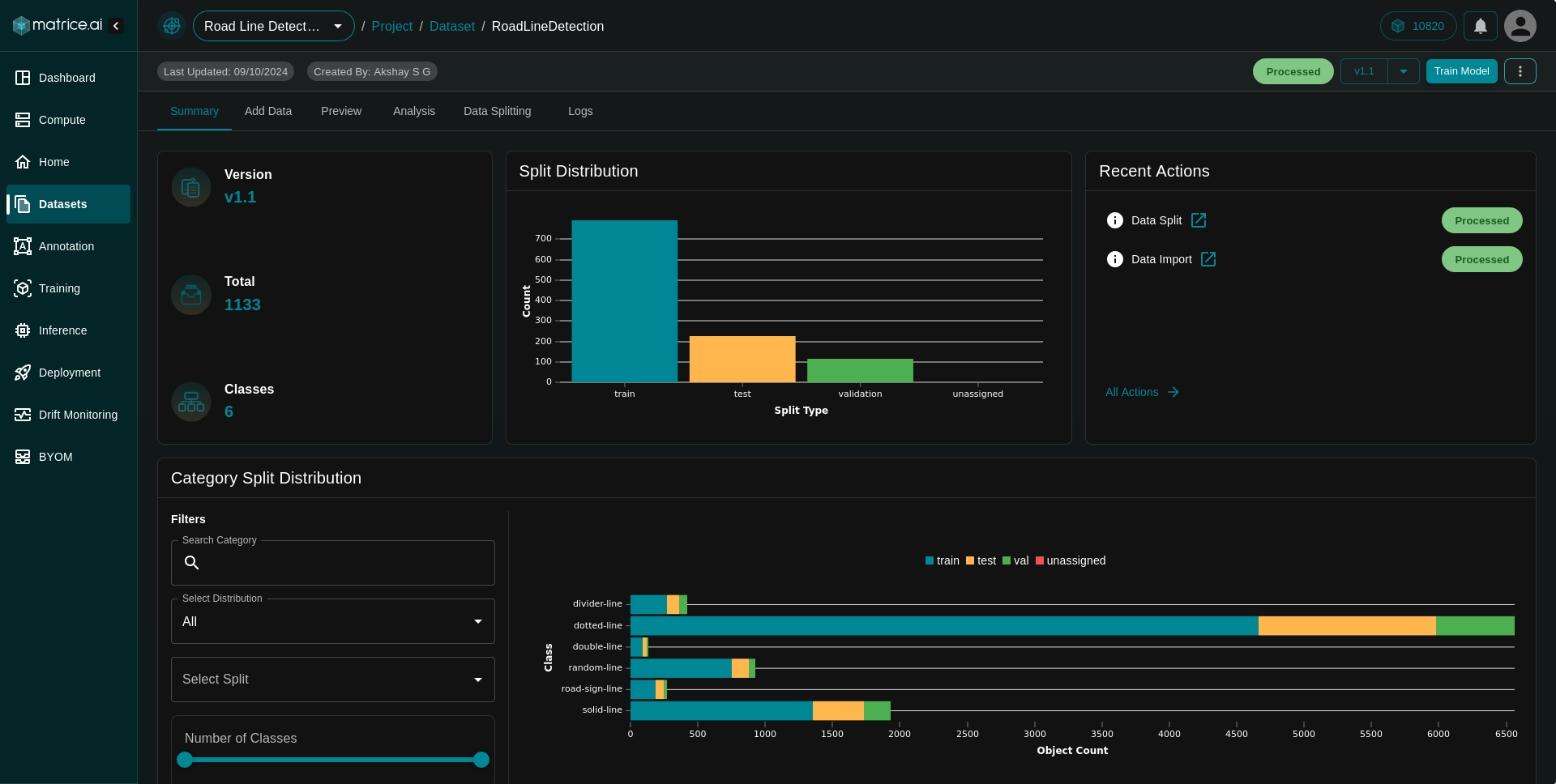
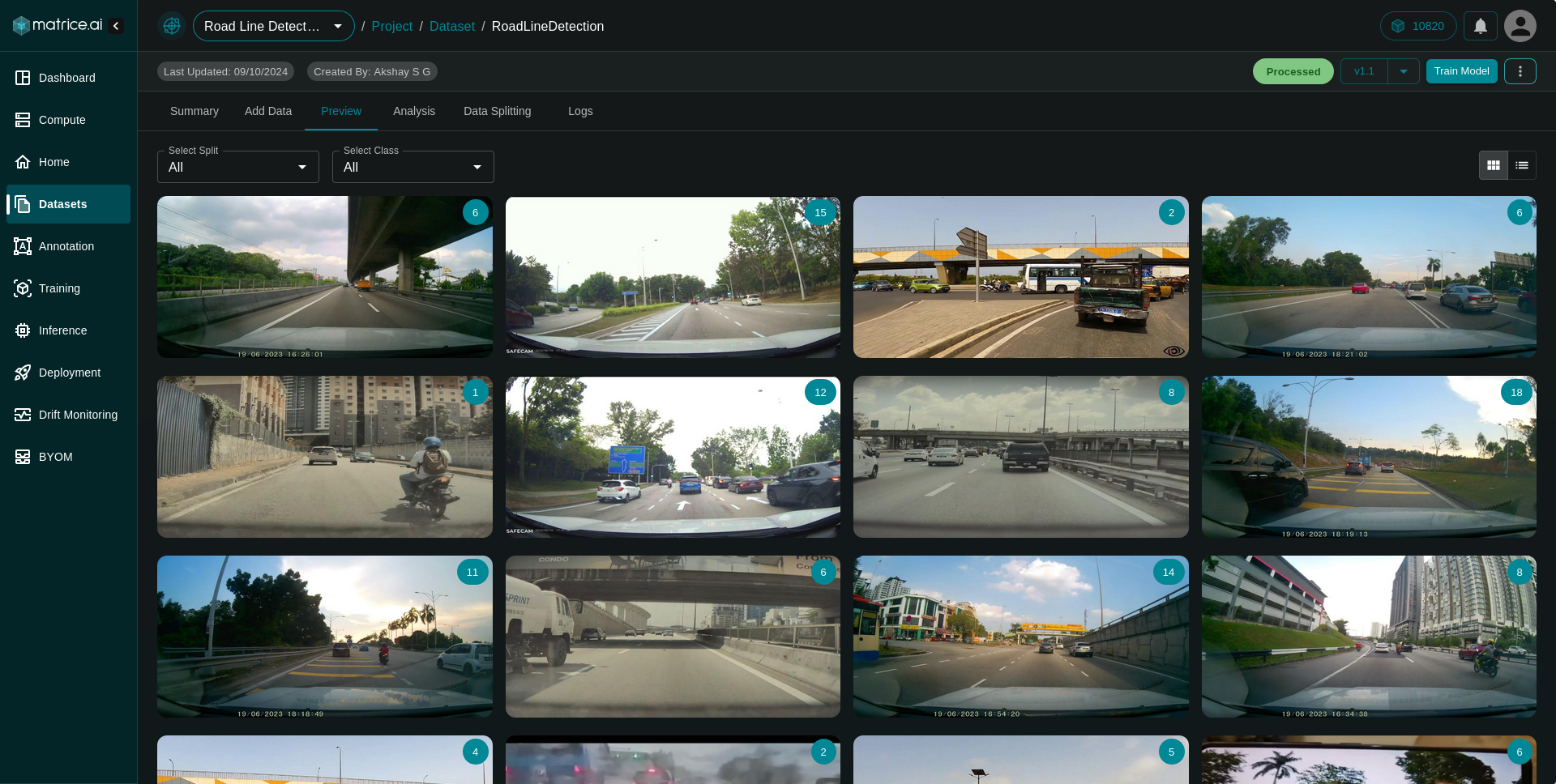
Step 2: Annotation
Annotation is key to a well-performing model. On Matrice’s platform, you can annotate your dataset right from the interface, labeling specific lane types and ensuring each image has the correct labels. Matrice’s annotation tools are intuitive, allowing you to define lane types accurately and speed up the labeling process.
Step 3: Training
Once your data is ready, it’s time to train the model. Matrice’s platform provides several State-of-the-art (SOTA) models for you to choose from. You can customize parameters based on your needs, and the platform takes care of the heavy lifting, including GPU utilization and optimizing the model’s training process. The training process is visually tracked on Matrice’s dashboard, letting you see model metrics like loss and accuracy in real-time.
Model Performance Comparison
Evaluating model performance is essential to ensure reliability in detecting lanes across different conditions. The following table provides a performance breakdown of the road lane detection model trained on Matrice, focusing on precision and recall metrics for both test and validation datasets:
Category |
Precision |
Recall |
||
|---|---|---|---|---|
Validation |
Test |
Validation |
Test |
|
all |
0.842 |
0.800 |
0.726 |
0.726 |
divider-line |
0.758 |
0.715 |
0.475 |
0.626 |
dotted-line |
0.900 |
0.894 |
0.818 |
0.777 |
double-line |
0.899 |
0.804 |
0.811 |
0.846 |
random-line |
0.646 |
0.745 |
0.540 |
0.688 |
road-sign-line |
0.952 |
0.816 |
0.857 |
0.586 |
solid-line |
0.896 |
0.823 |
0.854 |
0.832 |
Performance Insights
The model demonstrates strong performance across most lane categories:
Dotted-line and Solid-line Detection: The model achieves high precision and recall values in detecting dotted and solid lines, indicating its reliability in identifying these patterns under various conditions.
Divider-line Detection: While precision is moderate, recall is lower, especially in the validation set. This suggests the model may struggle with accurately identifying divider lines in more challenging environments, such as complex intersections or low-light conditions.
Road-sign-line Detection: This category shows excellent validation precision, but a slight drop in test recall. This could imply that the model performs well on the validation set but may need further tuning or more diverse data for robustness in real-world scenarios.
Random-line Detection: Performance is moderate for this category, with a slight discrepancy between test and validation metrics. Improving model accuracy in this category might require additional training data or adjustments to handle unpredictable lines better.
These insights can guide future model refinements and data collection strategies to improve lane detection accuracy further.
Highlights of Matrice’s Models Dashboard
Matrice’s Models dashboard offers an array of features to optimize model training and evaluation:
Model Performance by Category/Split: This feature enables detailed analysis of the model’s performance across various lane categories, helping to pinpoint strengths and areas for improvement.
Training Analysis for Loss: This section provides real-time insights into the model’s training loss, allowing you to monitor convergence and make adjustments during training if necessary.
Training Analysis for Performance: Performance metrics, including precision and recall, are tracked and displayed throughout the training process, giving you a clear picture of the model’s learning progress.
Model Test: Matrice makes it easy to test your trained model by simply dropping images into the dashboard. The model provides predictions and metrics on the spot, offering an interactive way to evaluate its real-world performance.
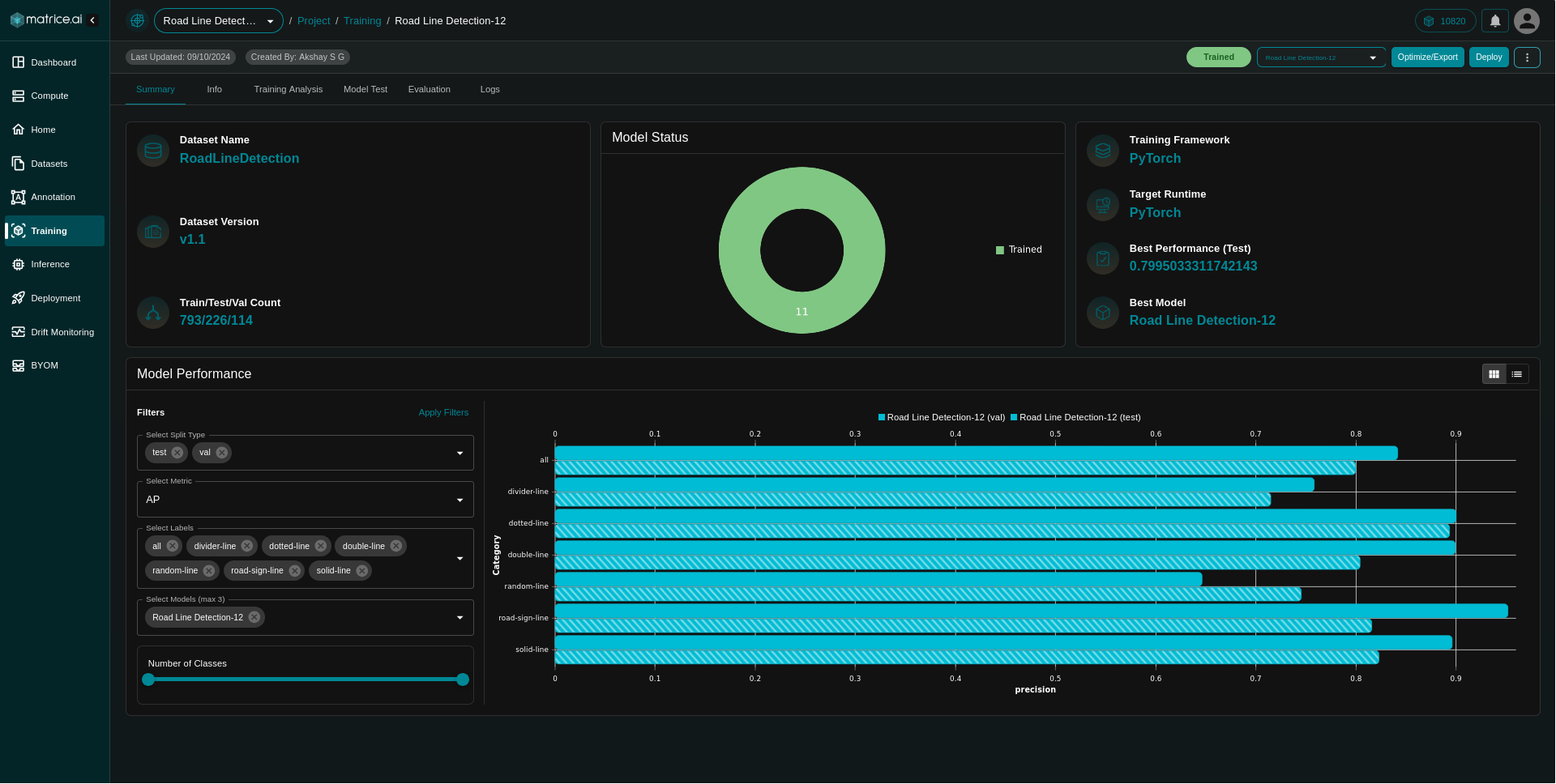
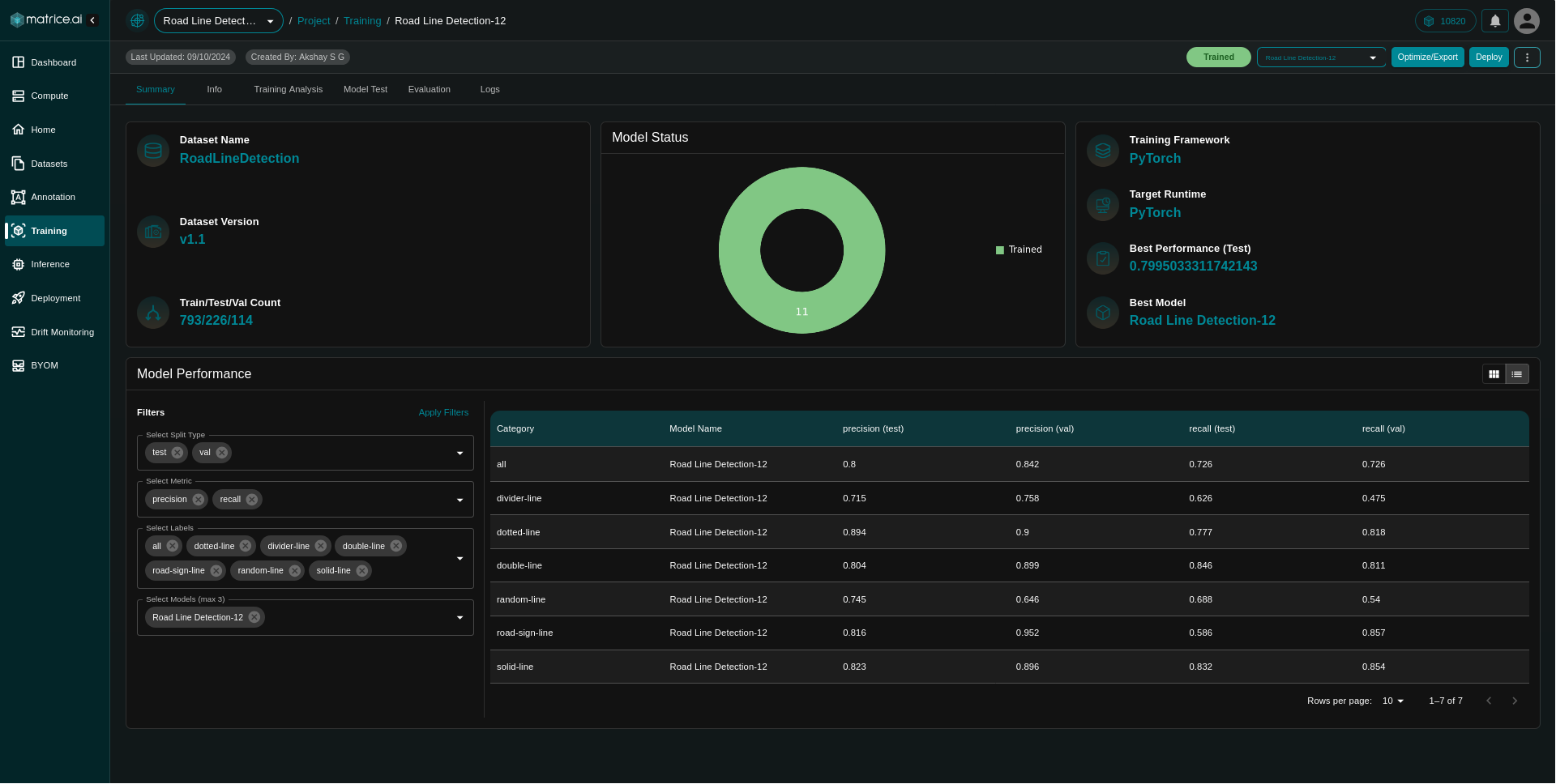
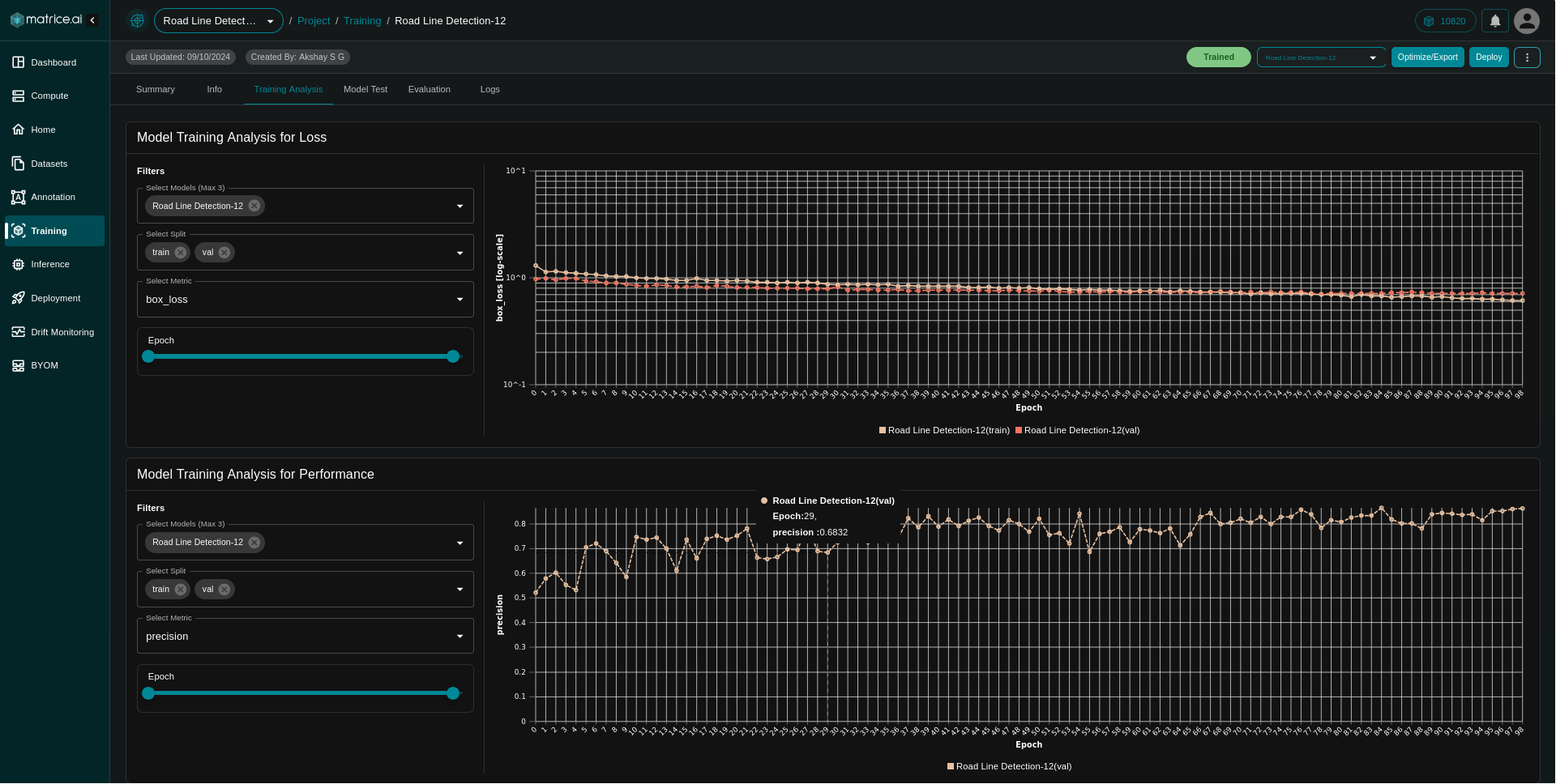
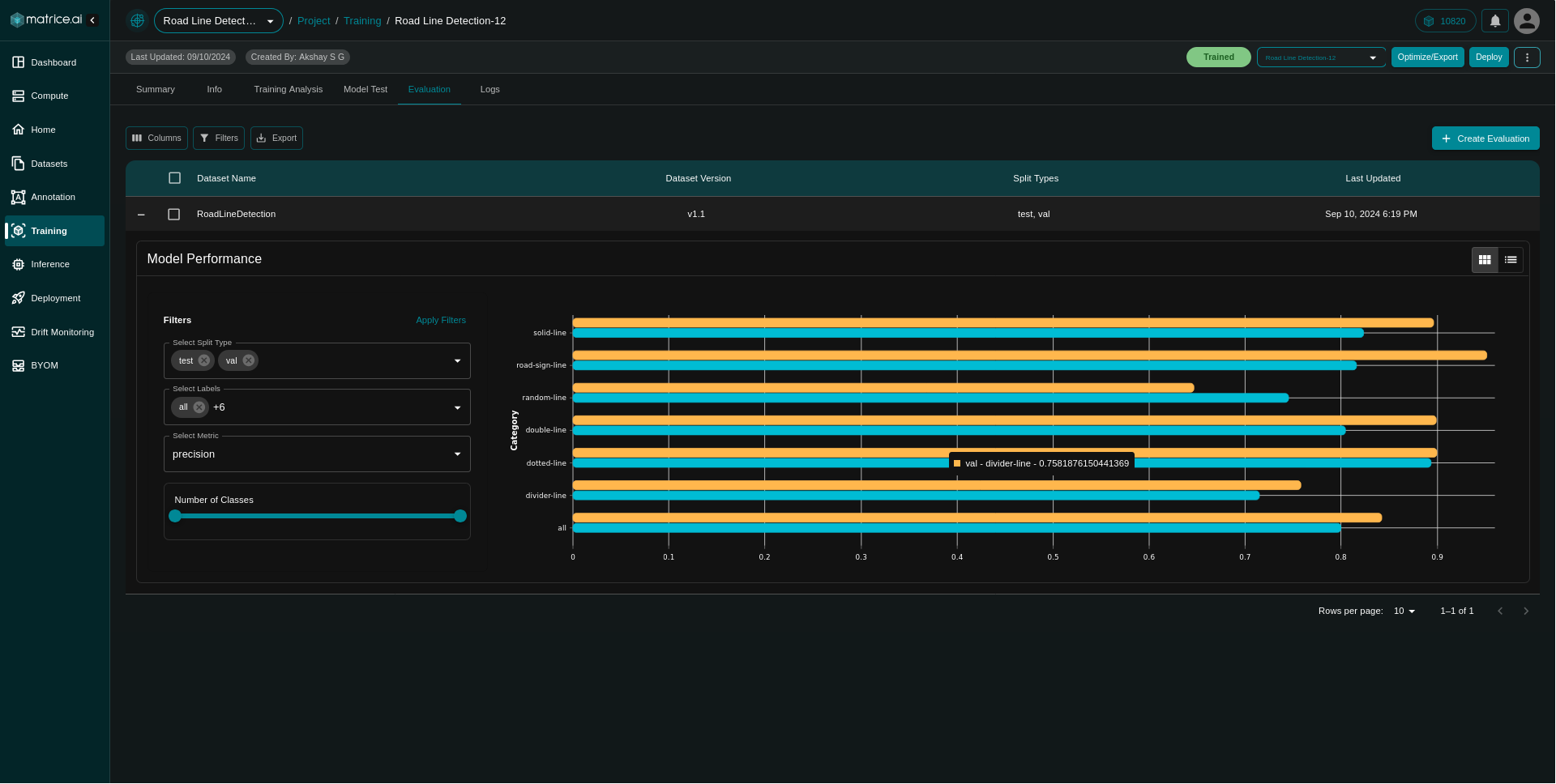
These features make Matrice an ideal choice for building and refining models, especially when you need actionable insights to improve model quality.
Step 4: Exporting the Model
Once training is complete, Matrice allows you to export the trained model. This is useful for integrating the model with other systems or further fine-tuning. Matrice supports various formats, making it easy to transfer your model wherever it’s needed.
Step 5: Deployment
Matrice’s deployment platform simplifies the process of bringing your model into production. With a few clicks, you can deploy your model to the cloud, where it can be accessed and tested by end users. Matrice’s deployment platform includes management tools, making it easy to monitor and control the model’s performance in real-world applications. Additionally, Matrice supports integrations with various programming languages, allowing for seamless integration into larger software solutions.
This five-step workflow, made easy by Matrice, ensures that even complex models like road lane detection can be developed and deployed without extensive technical knowledge.
Highlights of Matrice’s Deployment Dashboard
The Deployment platform on Matrice isn’t just a simple hosting service; it’s a complete management solution for cloud-based deployment. You can deploy your road lane detection model to the cloud, enabling seamless access and real-time testing. The platform supports integrations with various programming languages, allowing developers to incorporate the model into larger applications or systems. Additionally, the deployment platform provides tools for monitoring model usage, tracking performance, and scaling as needed.
Conclusion
Building and deploying a road lane detection model has never been more accessible, thanks to Matrice’s no-code platform. With Matrice, you can skip the coding hassle and focus on model development and testing. From importing data and annotating it to training, evaluating, and deploying, every step is simplified. Matrice’s comprehensive dashboards and management tools further ensure that your models perform optimally and are ready for production use.
Whether you’re in the automotive industry, working on ADAS technologies, or exploring autonomous driving, Matrice offers an all-in-one solution to bring your computer vision projects to life.
Think CV, Think Matrice
Experience 40% faster deployment and slash development costs by 80%